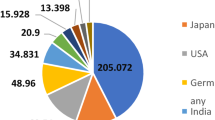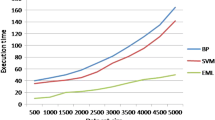Abstract
Electricity demand forecasting plays a crucial role in the operation of electrical power systems because it can provide management decisions related to load switching and power grid. Thus, there have been models developed to estimate the electricity demand. However, inaccurate demand forecasting may raise the operating cost of electric power sector, which means that it would waste considerable money. In this paper, a novel modeling framework was proposed for forecasting electricity demand. Sample entropy was developed to identify the nonlinearity and uncertainty in the original time series, after that redundant noise was removed through a decomposition technique. Besides, the most optimal modes of original series and the optimal input form of the model were determined by the feature selection method. Finally, electricity demand series can be conducted forecasting through least squares support vector machine tuned by multi-objective sine cosine optimization algorithm. The case studies of Australia demonstrated that the proposed framework can ensure high accuracy and strong stability. Thus, it can be considered as a useful tool for electricity demand forecasting.



Similar content being viewed by others
Abbreviations
- MBE:
-
Mean bias error
- QLD:
-
Queensland
- SE:
-
Sample entropy
- SA:
-
South Australia
- NSW:
-
New South Wales
- VMs:
-
Variational modes
- MAE:
-
Mean absolute error
- SCA:
-
Sine–cosine algorithm
- PSR:
-
Phase space reconstruction
- SVM:
-
Support vector machine
- ANN:
-
Artificial neural network
- LSSVM:
-
Least squares support vector machine
- ADMM:
-
Alternate direction method of multipliers
- ARIMA:
-
Autoregressive integrated moving average
- SARIMA:
-
Multi-objective sine cosine algorithm
- VMD:
-
Variational mode decomposition
- SE:
-
Sample entropy
- VM:
-
Variational modes
- DWT:
-
Discrete wavelet transform
- NWP:
-
Numerical weather prediction
- EMD:
-
Ensemble mode decomposition
- SVR:
-
Support vector regression
- THI:
-
Theil inequality coefficient
- MAPE:
-
Mean absolute percentage error
- PACF:
-
Partial autocorrelation function
- VMD:
-
Variational mode decomposition
- BPNN:
-
Backpropagation neural network
References
Fan S, Chen LN (2006) Short-term load forecasting based on an adaptive hybrid method. IEEE Trans Power Syst 21(1):392–401
Ying LC, Pan MC (2008) Using adaptive network based fuzzy inference system to forecast regional electricity loads. Energy Convers Manag 49(2):205–211
Wang X, Yang LT, Liu H, Deen MJ (2018) A big data-as-a-service framework: state-of-the-art and perspectives. IEEE Trans Big Data 4(3):325–340
Meadea N, Islam T (2015) Modelling European usage of renewable energy technologies for electricity generation. Technol Forecast Soc Change 90(Part B):497–509
Song M, Du Q, Zhu Q (2017) A theoretical method of environmental performance evaluation in the context of big data. Prod Plan Control 28(11–12):976–984
Saab S, Badr E, Nasr G (2001) Univariate modeling and forecasting of energy consumption: the case of electricity in Lebanon. Energy 26(1):1–14
De Felice M, Alessandri A, Ruti PM (2013) Electricity demand forecasting over Italy: potential benefits using numerical weather prediction models. Electr Power Syst Res 104:71–79
Al-Musaylh MS, Deo RC, Adarnowski JF, Li Y (2018) Short-term electricity demand forecasting with MARS, SVR and ARIMA models using aggregated demand data in Queensland, Australia. Adv Eng Inform 35:1–16
Vu DH, Muttaqi KM, Agalgaonkar AP, Bouzerdoum A (2017) Short-term electricity demand forecasting using autoregressive based time varying model incorporating representative data adjustment. Appl Energy 205:790–801
Yang Y, Chen YH, Wang YC, Li CH, Li L (2016) Modelling a combined method based on ANFIS and neural network improved by DE algorithm: a case study for short-term electricity demand forecasting. Appl Soft Comput 49:663–675
Williams S, Short M (2020) Electricity demand forecasting for decentralised energy management. Energy Built Environ 1(2):178–186
Chang PC, Fan CY, Lin JJ (2011) Monthly electricity demand forecasting based on a weighted evolving fuzzy neural network approach. Int J Electr Power Energy Syst 33(1):17–27
An N, Zhao WG, Wang JZ, Shang D, Zhao ED (2013) Using multi-output feedforward neural network with empirical mode decomposition based signal filtering for electricity demand forecasting. Energy 49:279–288
Bedi J, Toshniwal D (2019) Deep learning framework to forecast electricity demand. Appl Energy 238:1312–1326
Jiang P, Li RR, Liu NN, Gao YY (2020) A novel composite electricity demand forecasting framework by data processing and optimized support vector machine. Appl Energy 260:114243. https://doi.org/10.1016/j.apenergy.2019.114243
AL-Musaylh MS, Deo RC, Adamowski JF, Li Y (2019) Short-term electricity demand forecasting using machine learning methods enriched with ground-based climate and ECMWF Reanalysis atmospheric predictors in southeast Queensland, Australia. Renew Sustain Energy Rev 113:109293
Song ZY, Niu DX, Dai SY, Xiao XL, Wang YW (2017) Incorporating the influence of China’s industrial capacity elimination policies in electricity demand forecasting. Util Policy 47:1–11
Ren Y, Suganthan PN, Srikanth N, Amaratunga G (2016) Random vector functional link network for short-term electricity load demand forecasting. Inf Sci 367:1078–1093
Shao Z, Gao F, Yang SL, Yu BG (2015) A new semiparametric and EEMD based framework for mid-term electricity demand forecasting in China: hidden characteristic extraction and probability density prediction. Renew Sustain Energy Rev 52:876–889
He YX, Jiao J, Chen Q, Ge SF, Chang Y, Xu Y (2017) Urban long term electricity demand forecast method based on system dynamics of the new economic normal: the case of Tianjin. Energy 133:9–22
Laouafi A, Mordjaoui M, Laouafi F, Boukelia TE (2016) Daily peak electricity demand forecasting based on an adaptive hybrid two-stage methodology. Int J Electr Power Energy Syst 77:136–144
Burillo D, Chester MV, Ruddell B, Johnson N (2017) Electricity demand planning forecasts should consider climate non-stationarity to maintain reserve margins during heat waves. Appl Energy 206:267–277
De Felice M, Alessandri A, Catalano F (2015) Seasonal climate forecasts for medium-term electricity demand forecasting. Appl Energy 137:435–444
El-Shazly A (2013) Electricity demand analysis and forecasting: a panel cointegration approach. Energy Econ 40:251–258
Gunay ME (2016) Forecasting annual gross electricity demand by artificial neural networks using predicted values of socio-economic indicators and climatic conditions: case of Turkey. Energy Policy 90:92–101
Jiang P, Li R, Lu H et al (2019) Modeling of electricity demand forecast for power system. Neural Comput Appl. https://doi.org/10.1007/s00521-019-04153-5
Shaikh F, Ji Q (2016) Forecasting natural gas demand in China: logistic modelling analysis. Int J Electr Power Energy Syst 77:25–32
Kelo S, Dudul S (2012) A wavelet Elman neural network for short-term electrical load prediction under the influence of temperature. Int J Electr Power Energy Syst 43(1):1063–1071
Ghofrani M, Ghayekhloo M, Arabali A, Ghayekhloo A (2015) A hybrid short-term load forecasting with a new input selection framework. Energy 81:777–786
Singh P, Dwivedi P (2018) Integration of new evolutionary approach with artificial neural network for solving short term load forecast problem. Appl Energy 217:537–549
Khwaja AS, Zhang X, Anpalagan A, Venkatesh B (2017) Boosted neural networks for improved short-term electric load forecasting. Electr Power Syst Res 143:431–437
Karimi M, Karami H, Gholami M, Khatibzadehazad H, Moslemi N (2018) Priority index considering temperature and date proximity for selection of similar days in knowledge-based short term load forecasting method. Energy 144:928–940
Fang K, Jiang Y, Song M (2016) Customer profitability forecasting using Big Data analytics: a case study of the insurance industry. Comput Ind Eng 101:554–564
Efendi R, Ismail Z, Deris MM (2015) A new linguistic out-sample approach of fuzzy time series for daily forecasting of Malaysian electricity load demand. Appl Soft Comput 28:422–430
Ju FY, Hong WC (2013) Application of seasonal SVR with chaotic gravitational search algorithm in electricity forecasting. Appl Math Model 37(23):9643–9651
Kandananond K (2011) Forecasting electricity demand in Thailand with an artificial neural network approach. Energies 4(8):1246–1257
Hassan S, Khosravi A, Jaafar J, Khanesar MA (2016) A systematic design of interval type-2 fuzzy logic system using extreme learning machine for electricity load demand forecasting. Int J Electr Power Energy Syst 82:1–10
Kaytez F, Taplamacioglu MC, Cam E, Hardalac F (2015) Forecasting electricity consumption: a comparison of regression analysis, neural networks and least squares support vector machines. Int J Electr Power Energy Syst 67:431–438
Chang EH, Zhu GN, Chen JW (2015) A combined model based on cuckoo search algorithm for electrical load forecasting. Appl Mech Mater 737:278–282
Kucukali S, Baris K (2010) Turkey’s short-term gross annual electricity demand forecast by fuzzy logic approach. Energy Policy 38(5):2438–2445
Wang DY, Luo HY, Grunder O, Lin YB, Guo HX (2017) Multi-step ahead electricity price forecasting using a hybrid model based on two-layer decomposition technique and BP neural network optimized by firefly algorithm. Appl Energy 190:390–407
Deo RC, Wen XH, Qi F (2016) A wavelet-coupled support vector machine model for forecasting global incident solar radiation using limited meteorological dataset. Appl Energy 168:568–593
Rathinasamy M, Khosa R, Adamowski J, Ch S, Partheepan G, Anand J, Narsimlu B (2014) Wavelet-based multiscale performance analysis: an approach to assess and improve hydrological models. Water Resour Res 50(12):9721–9737
Xiong T, Bao YK, Hu ZY (2014) Interval forecasting of electricity demand: a novel bivariate EMD-based support vector regression modeling framework. Int J Electr Power Energy Syst 63:353–362
Liu H, Tian HQ, Liang XF, Li YF (2015) Wind speed forecasting approach using secondary decomposition algorithm and Elman neural networks. Appl Energy 157:183–194
Qiu XH, Suganthan PN, Amaratunga GAJ (2018) Ensemble incremental learning Random Vector Functional Link network for short-term electric load forecasting. Knowl Based Syst 145:182–196
Lahmiri S (2016) A variational mode decompoisition approach for analysis and forecasting of economic and financial time series. Expert Syst Appl 55:268–273
Chou CM (2014) Complexity analysis of rainfall and runoff time series based on sample entropy in different temporal scales. Stoch Environ Res Risk Assess 28(6):1401–1408
Stosic T, Telesca L, Ferreira DVD, Stosic B (2016) Investigating anthropically induced effects in streamflow dynamics by using permutation entropy and statistical complexity analysis: a case study. J Hydrol 540:1136–1145
Zurek S, Guzik P, Pawlak S, Kosmider M, Piskorski J (2012) On the relation between correlation dimension, approximate entropy and sample entropy parameters, and a fast algorithm for their calculation. Physica A 391(24):6601–6610
Richman JS, Moorman JR (2000) Physiological time-series analysis using approximate entropy and sample entropy. Am J Physiol Heart Circ Physiol 278(6):H2039–H2049
Li HM, Wang JZ, Li RR, Lu HY (2019) Novel analysis-forecast system based on multi-objective optimization for air quality index. J Clean Prod 208:1365–1383
Wang YK, Tao YW, Sheng D, Zhou YT, Wang D, Shi XR, Wu JC, Ma XR (2020) Quantifying the change in streamflow complexity in the Yangtze River. Environ Res 180:108833
Li RR, Jin Y (2018) A wind speed interval prediction system based on multi-objective optimization for machine learning method. Appl Energy 228:2207–2220
Dragomiretskiy K, Zosso D (2014) Variational Mode Decomposition. IEEE Trans Signal Process 62(3):531–544
Mirjalili S (2016) SCA: A sine cosine algorithm for solving optimization problems. Knowl Based Syst 96:120–133
Jiang P, Li RR, Li HM (2019) Multi-objective algorithm for the design of prediction intervals for wind power forecasting model. Appl Math Model 67:101–122
Li B, Li DY, Zhang ZJ, Yang SM, Wang F (2015) Slope stability analysis based on quantum-behaved particle swarm optimization and least squares support vector machine. Appl Math Model 39(17):5253–5264
Zhu BZ, Wei YM (2013) Carbon price forecasting with a novel hybrid ARIMA and least squares support vector machines methodology. Omega Int J Manag Sci 41(3):517–524
Author information
Authors and Affiliations
Corresponding author
Ethics declarations
Conflict of interest
The authors declare that they have no known competing financial interests or personal relationships that could have appeared to influence the work reported in this paper.
Additional information
Publisher's Note
Springer Nature remains neutral with regard to jurisdictional claims in published maps and institutional affiliations.
Rights and permissions
About this article
Cite this article
Li, R., Chen, X., Balezentis, T. et al. Multi-step least squares support vector machine modeling approach for forecasting short-term electricity demand with application. Neural Comput & Applic 33, 301–320 (2021). https://doi.org/10.1007/s00521-020-04996-3
Received:
Accepted:
Published:
Issue Date:
DOI: https://doi.org/10.1007/s00521-020-04996-3




